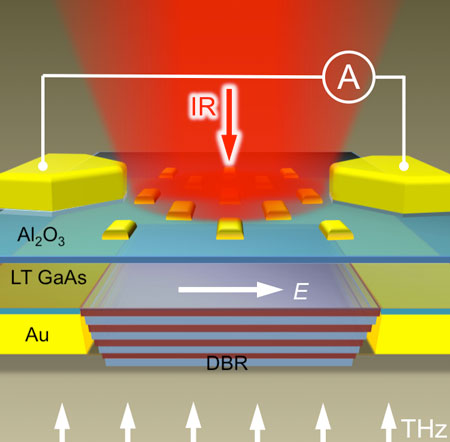| Posted: Nov 25, 2015 |
Nano-antennas assist in improving spatial resolution of terahertz microscopy
(Nanowerk News) A team lead by a London Centre for Nanotechnology (LCN) researcher has demonstrated a detector for terahertz waves with integrated optical nano-antennas. The detector enables enhanced spatial resolution in terahertz microscopy (ACS Photonics, "Photoconductive terahertz near-field detector with a hybrid nanoantenna array cavity").
|
|
Similar to more commonly used infra-red waves and X-rays, terahertz waves allow observing objects and phenomena invisible to the human eye. However clarity of terahertz images is limited by the ability of light to pass around objects smaller than the light’s wavelength. A technique called near-field scanning probe microscopy, pioneered in UCL over 40 years ago, overcomes this limit and opens doors to investigations of sub-wavelength scale objects.
|
|
To advance resolution capabilities of near-field scanning probe microscopy with terahertz waves, the research team developed a nano-scale structure, consisting of an array of optical nano-antennas and a distributed Bragg reflector. When illuminated by a short optical pulse, this structure traps optical photons within a small region and activates a small terahertz detector, which allows sampling terahertz waves on the scale over 100 times smaller than the terahertz wavelength.
|
 |
| Schematic diagram of the terahertz near-field probe containing the nano-structured terahertz detector and a sub-wavelength size aperture. White arrows indicate the incident terahertz wave and its electric field induced in the active region. To detect this field, the active region is switched on by optical gating pulses (red arrow)
|
|
The researchers monolithically integrated the terahertz detector with sub-wavelength scale apertures, as small as 2 µm, creating high-resolution near-field terahertz probes.
|
|
They anticipate that applications of these probes with a powerful analytical technique for scientific investigations, called terahertz time-domain spectroscopy (THz-TDS), will aid in development of future electronics.
|
|
This research was supported by the Royal Society and it was carried out in collaboration with scientists at the Centre for Integrated Nanotechnologies, Sandia National Laboratory.
|

